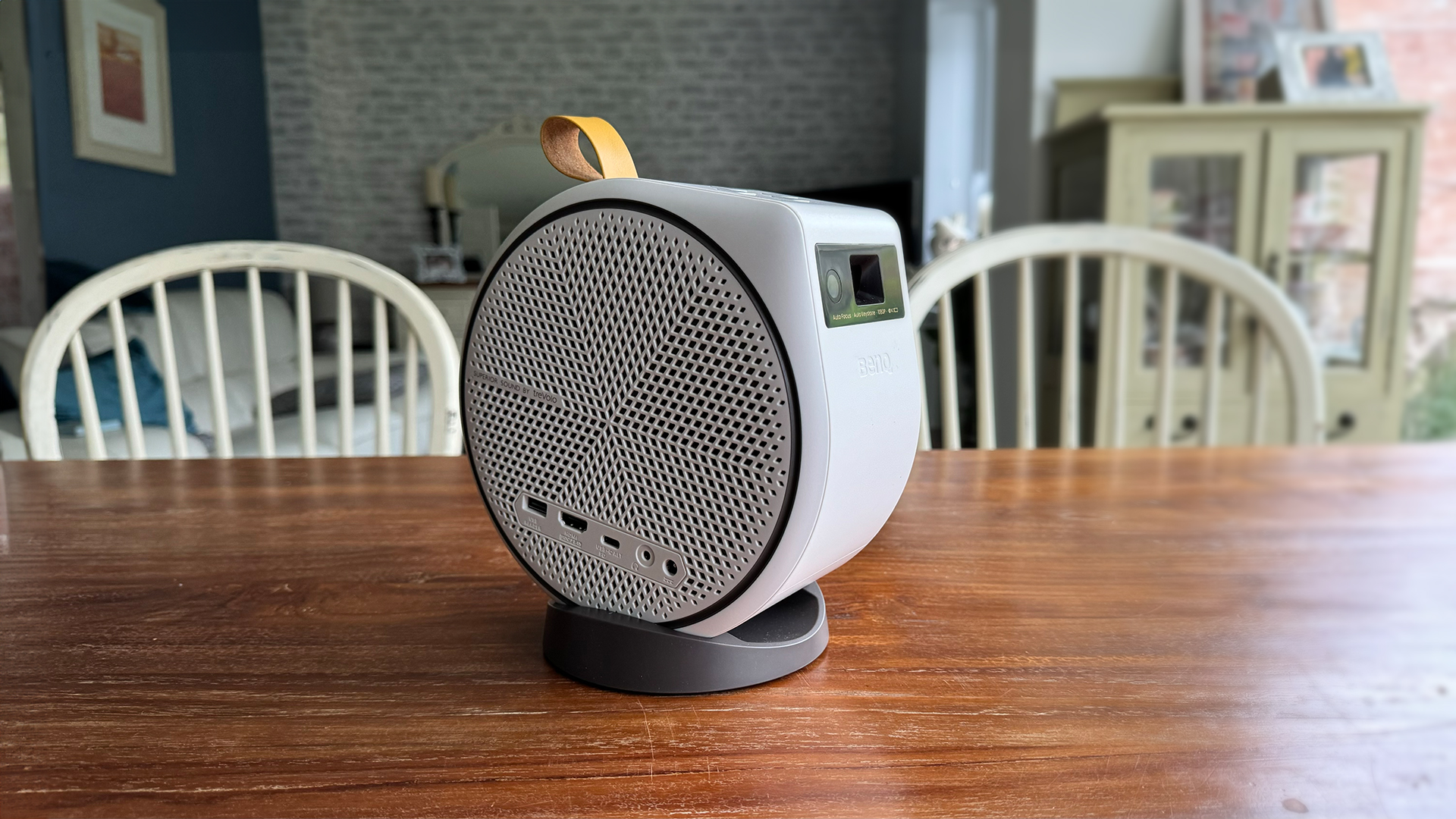
Lifestyle projectors are all the rage right now, serving up all kinds of weird and wonderful designs as manufacturers try to find original ways to cater for the apparently thriving ‘movies anywhere’ market. No convenience-focused projector we’ve seen before, though, has looked quite like BenQ’s GV31.
Its mostly circular shape slots vertically into a simple desktop cradle within which, crucially, it can be rotated through 135 degrees to show images on either a wall or – get this, lazy home cinema fans – ceiling, for when lying down to watch a film is the only thing that will do.
Much as we applaud any effort to help us go from couch potatoes to bed potatoes, though, surely such a radical lifestyle projector design can’t also do the business in performance terms, can it?
Price
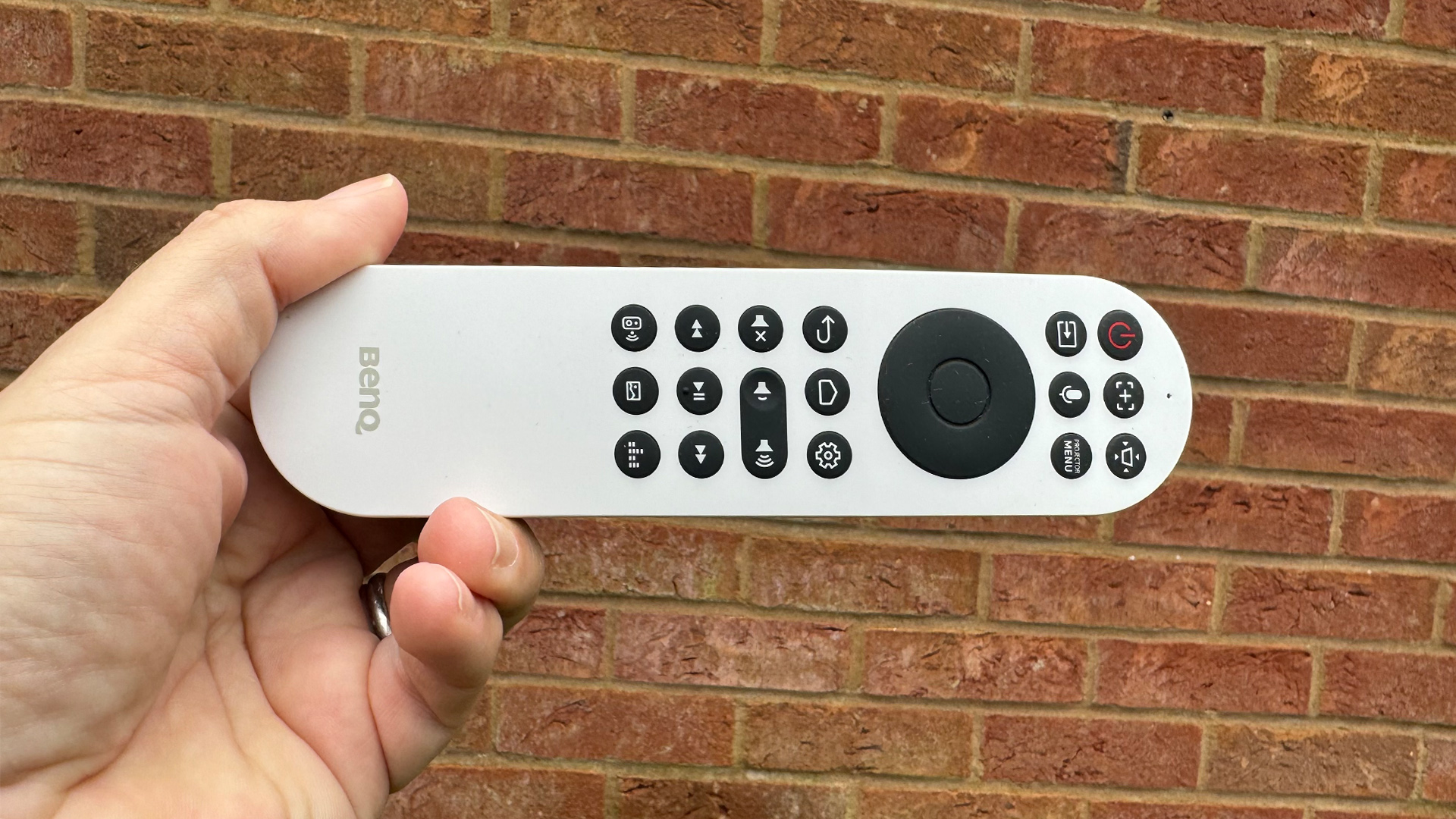
The BenQ GV31’s £499 / $599 / $999 Australian prices all look pretty consistent with local exchange rates taken into account – and all feel about right for a projector with a unique and convenient design but one or two related performance limitations in tow.
Perhaps the closest projector rival to the GV31 right now, in the sense that it also sits in a cradle within which it can be rotated through (actually more than) 135 degrees, is Samsung’s barrel-shaped The Freestyle. This is much smaller and more portable than the GV31, though, and at the time of writing typically costs around 20 per cent more than BenQ’s ceiling projector.
Design
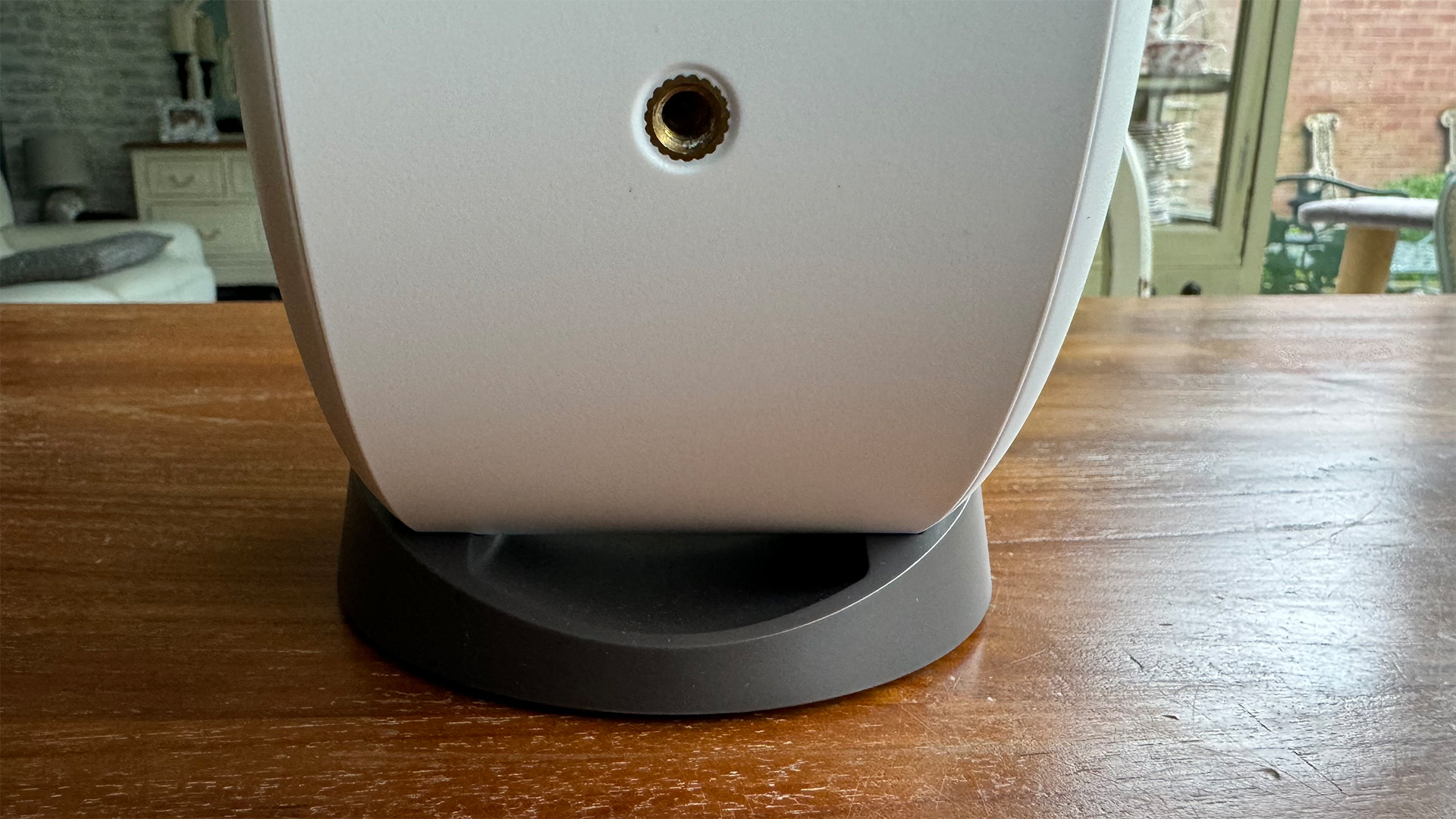
The BenQ GV31 ships in two parts: the main projector and a mounting base. The projector features a highly unusual upright circular design, where its 20cm high wheel-like body is only broken by a single angular protrusion containing a rectangular lens aperture outlet. The only other addition to the body is a cute little leather carry hoop near the lens protrusion.
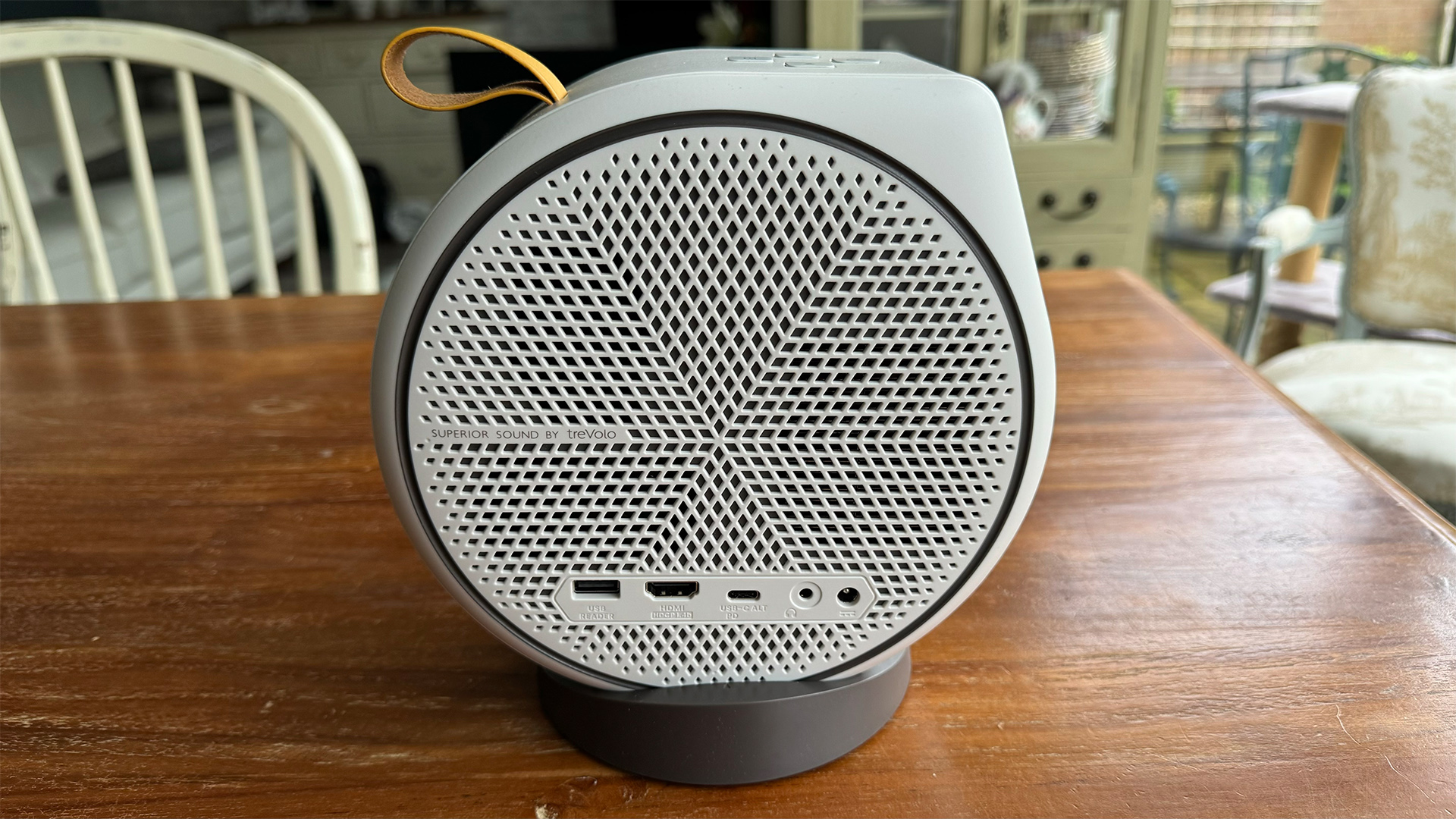
Projector type DLP LED
Processing CinematicColor technology
Screen size Up to 120 inches
Native resolution 1080p
Input lag 45ms
HDR support? No
Dimensions (hwd) 19 x 13 x 20 cm
Weight 1.7kg
BenQ further supports the GV31’s portability with drop-proofing that’s reckoned to hold good to a height of 50cm. Though if you’re on the clumsy side and envisage moving the projector around a lot, you’d probably be well advised to invest in the GV31’s optional carry case.
The sides of the GV31’s wheel shape feature grilled finishes to allow the projector to emit both heat from its LED lighting system and sound from an integrated stereo speaker system.
The circular projector stands surprisingly stably – aided by a gentle magnetic ‘grip’ – within the base, while also rotating smoothly around when you want to adjust the projected image’s orientation from the wall to the ceiling.
Overall it’s a design that doesn’t look like it should work, but actually does. And it’s compact enough, too, to sit on a bedside table.
Features
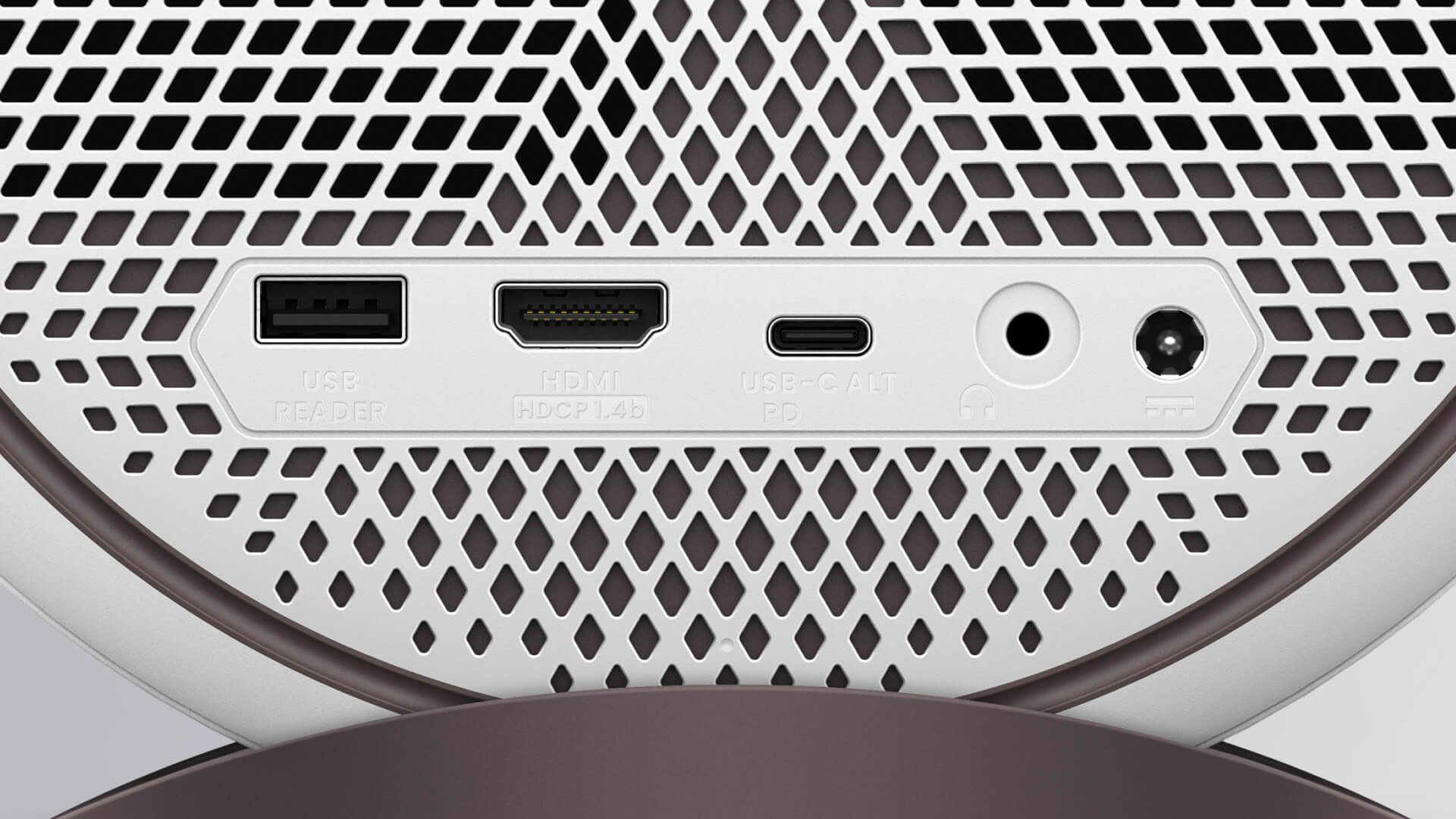
Clearly, the GV31’s design is also its biggest feature; upright circular projectors that can be rotated through 135 degrees to support watching films on your ceiling aren’t exactly 10 a penny. The clever way the design is used to integrate a 4W speaker into each side (with a claimed soundstage splay of more than 270 degrees) and an 8W subwoofer ‘chamber’ is also a nice touch which, as we’ll see, pays off handsomely.
So confident is BenQ in the GV31’s audio performance, in fact, that it even provides the option to use it as a wireless speaker for streaming music from your phone or tablet.
The projector uses an LED lamp system that’s impressively rated as being capable of running for more than 20,000 hours (or 30,000 hours if you use its Eco picture setting) before giving up the ghost.
The maximum brightness BenQ claims for the GV31, though, is only 300 ANSI Lumens; a lowly figure that casts doubt on BenQ’s suggestion that the GV31 is capable of delivering a maximum 120-inch image size. Experience suggests that something between 60 and, at a push, 80 inches would usually be about the furthest to which you could stretch a 300 ANSI Lumens projected image before it started to become too dark for comfortable viewing.
The GV31 supports 1080p Full HD images rather than 4K, but this is only to be expected with such a convenience-based and affordable projector.
As we’re increasingly starting to expect of lifestyle projectors, the GV31 carries an auto set-up system that automatically and effectively corrects both focus and vertical keystone errors. Add in an Android TV smart system (provided via a supplied BenQ dongle) and the GV31 really is a plug-and-play product.
You don’t even need to plug the projector into the wall, as it backs up its highly portable and convenient approach to projection with a built-in rechargeable battery capable of delivering up to 180 minutes of video playback or 300 minutes of music (depending on the brightness and volume levels you use, of course).
Connectivity includes a pair of HDMI 1.4b ports: one external and one tucked within the projector’s bodywork, so you can keep the provided Android TV dongle out of sight. There’s also a USB Type A port that can function as a 1.0A power supply or file reader, and a USB-C port that supports a wider range of power supply options and firmware upgrades. You can even charge the projector’s battery from a USB-C power bank.
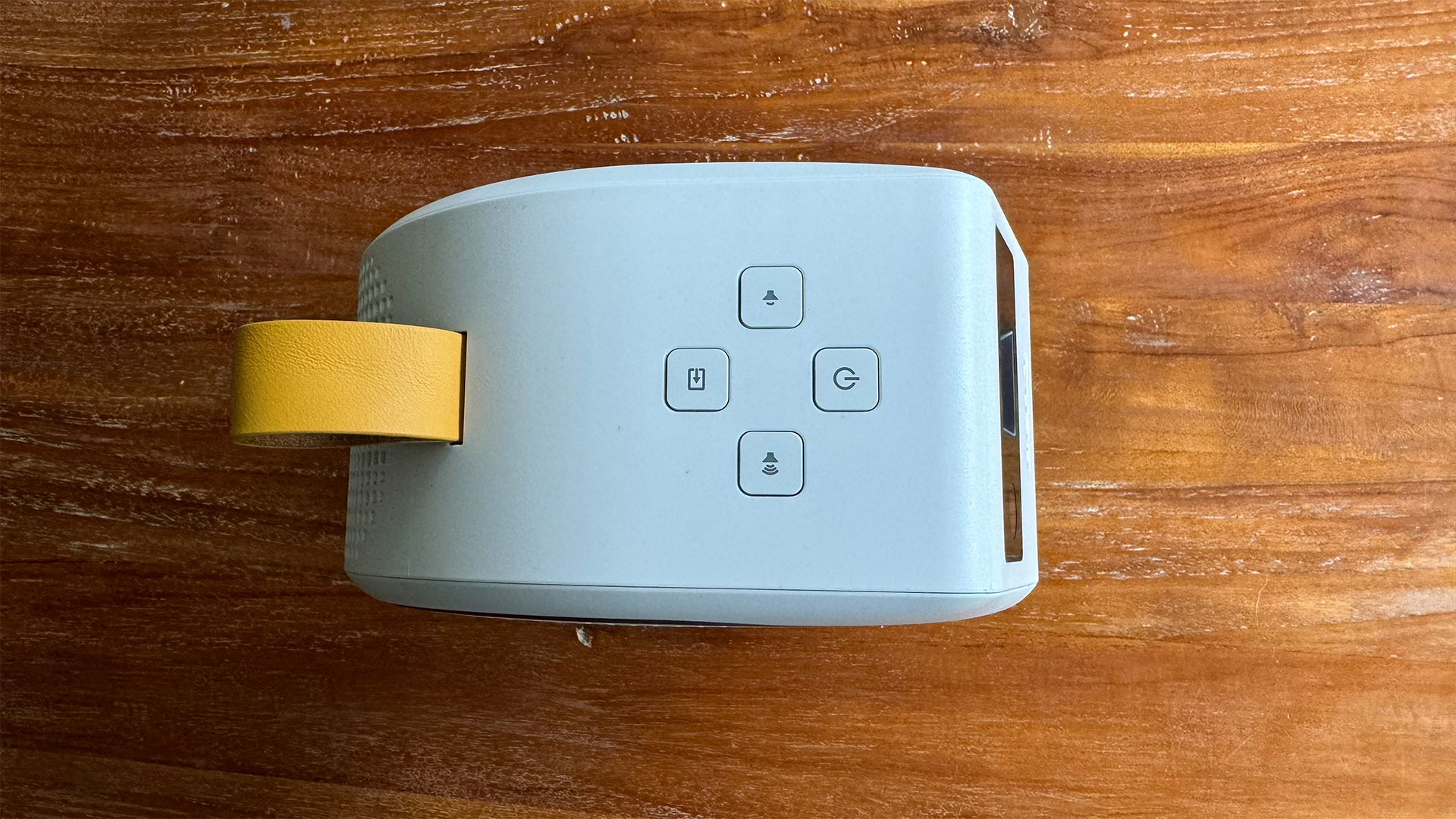
The wired connections are supported by both Bluetooth (5.0) and wi-fi (802.11, 5GHz) wireless options. The wi-fi feeds the streaming services of the included Android 11.0 smart system, of course, while there’s also Airplay and Google Cast support for sharing content from your other Apple and Android devices.
While most projectors not focussed exclusively on high-end home cinema these days feature integrated smart systems, the quality of these systems can vary massively. The GV31’s Android platform fits in the ‘average’ category, at least for UK users, as it doesn’t include (at the time of writing, anyway) the BBC iPlayer, ITVX or All 4 catch-up apps.
We are able to use Netflix, Disney+, Apple TV, Now, Paramount+, Rakuten, My5, YouTube, Discovery+ and Pluto TV apps, though, and there’s even support for Google Assistant voice control via a mic in the projector’s remote control.
Unlike many of today’s projectors, there’s no support from the GV31 for HDR from either external or streamed sources. Though with just 300 lumens of brightness to play with, sticking with SDR is almost certainly for the best.
BenQ does claim, though, that the GV31 can deliver up to 98 per cent of the Rec 709 SDR colour range courtesy of the brand’s CinematicColor technology, and it backs this up with an eye-catchingly high contrast ratio claim of 100,000:1.
If you fancy a break from watching films in bed to play games on the GV31, you won’t find any particular game-enhancing features. It only supports 60Hz frame rates (at HD resolution in SDR, of course), and it takes a rather average 45ms to render graphics received at its HDMIs.
Picture
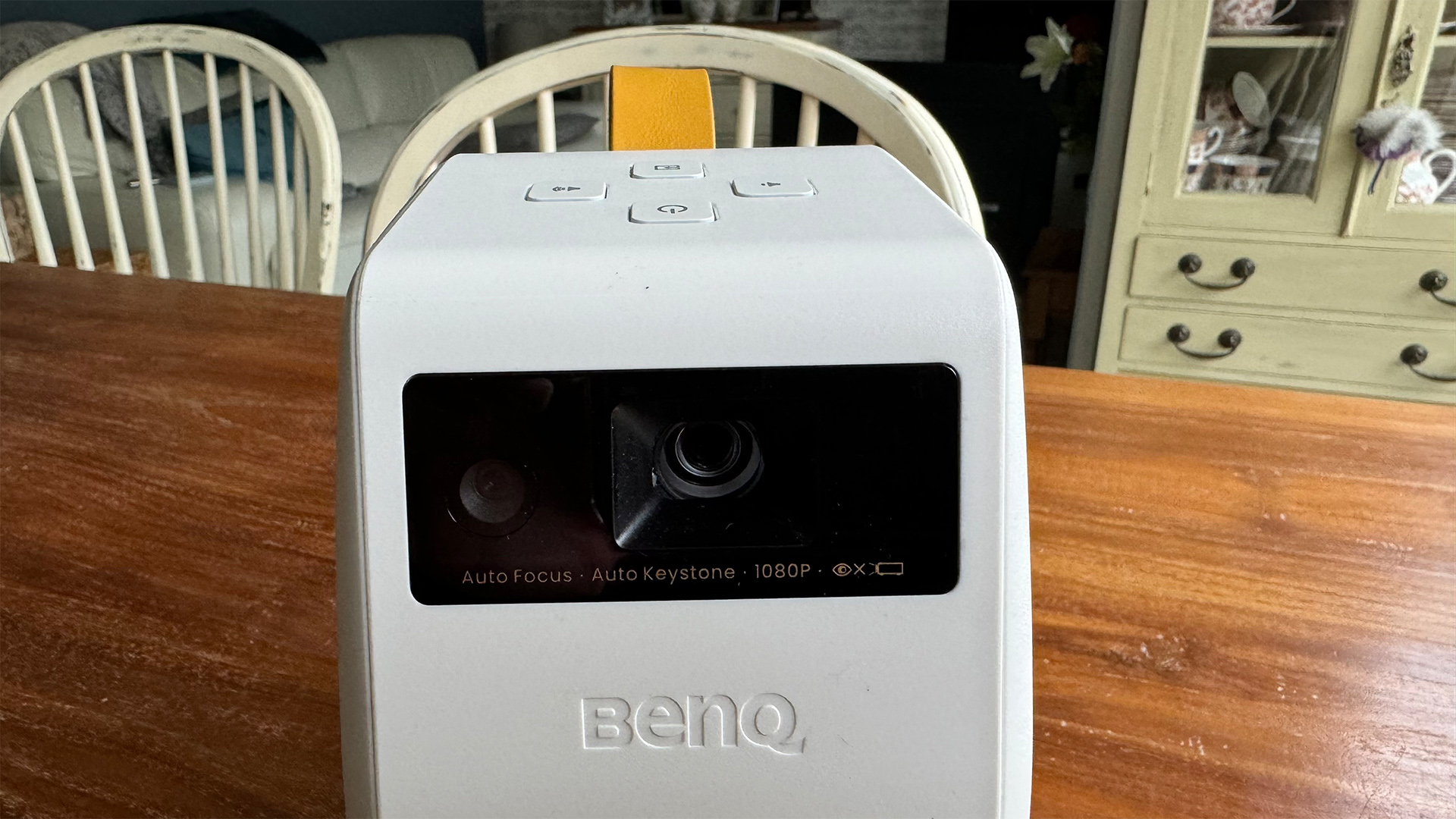
Let’s deal with the bad news first: as feared, the GV31 really isn’t very bright. By the time we’d pushed its images to around 80 inches across they were starting to look too dim to be enjoyable – even in a darkened room. In fact, we’d recommend not going above 70 inches if you want dark scenes not to suffer with lost shadow details and bright scenes to have any punch. And you probably need to knock another 10 inches off that if there’s any sort of ambient light in the room.
There is a Bright mode among the projector’s presets, which can help a touch if you want to try for a bigger image than 70 inches. Unfortunately, though, this mode introduces a strong blue undertone to the picture that leaves pretty much everything looking weird and unnatural. A Daylight preset is actually a better bet for relatively large image sizes, since, while not as intense as the Bright mode, it doesn’t suffer nearly as much with the disruptive blue tone. Instead, though, its colours can look a little desaturated.
In the end, after experimenting with the projector’s set-up features, we settle back on our initial finding that the GV31 is really at its best with images up to around 70 inches across. So given that there’s no optical zoom available on the projector and the image size gets to 70-80 inches from a throw distance of around 7 feet, you might find sticking to that maximum image size an issue if your bedroom happens to have an unusually high ceiling.
Once we’ve come to terms with the limitations associated with the GV31’s brightness, though, we really start to warm to it. Not least because it manages to produce surprisingly credible black colours and, as a result, unexpectedly compelling dark scenes for such an affordable and convenience-focussed projector.
What’s more, provided you keep the image to a size where brightness doesn’t drop too much, these engaging, cinematic black tones don’t come at the expense of reasonable amounts of shadow detail.
Decent black levels are usually accompanied by relatively punchy and natural-looking colours – and so it proves with the GV31, especially if you use the Living Room picture mode that seems to have been tuned to get the best all-round results out of the GV31’s optics. In this mode, colour tones look more vibrant than you would think possible with so little brightness to feed them. But at the same time, there’s enough subtlety to blends and washes to ensure that the boldness isn’t accompanied by noise, a cartoonish lack of tonal subtlety, or a lack of depth.
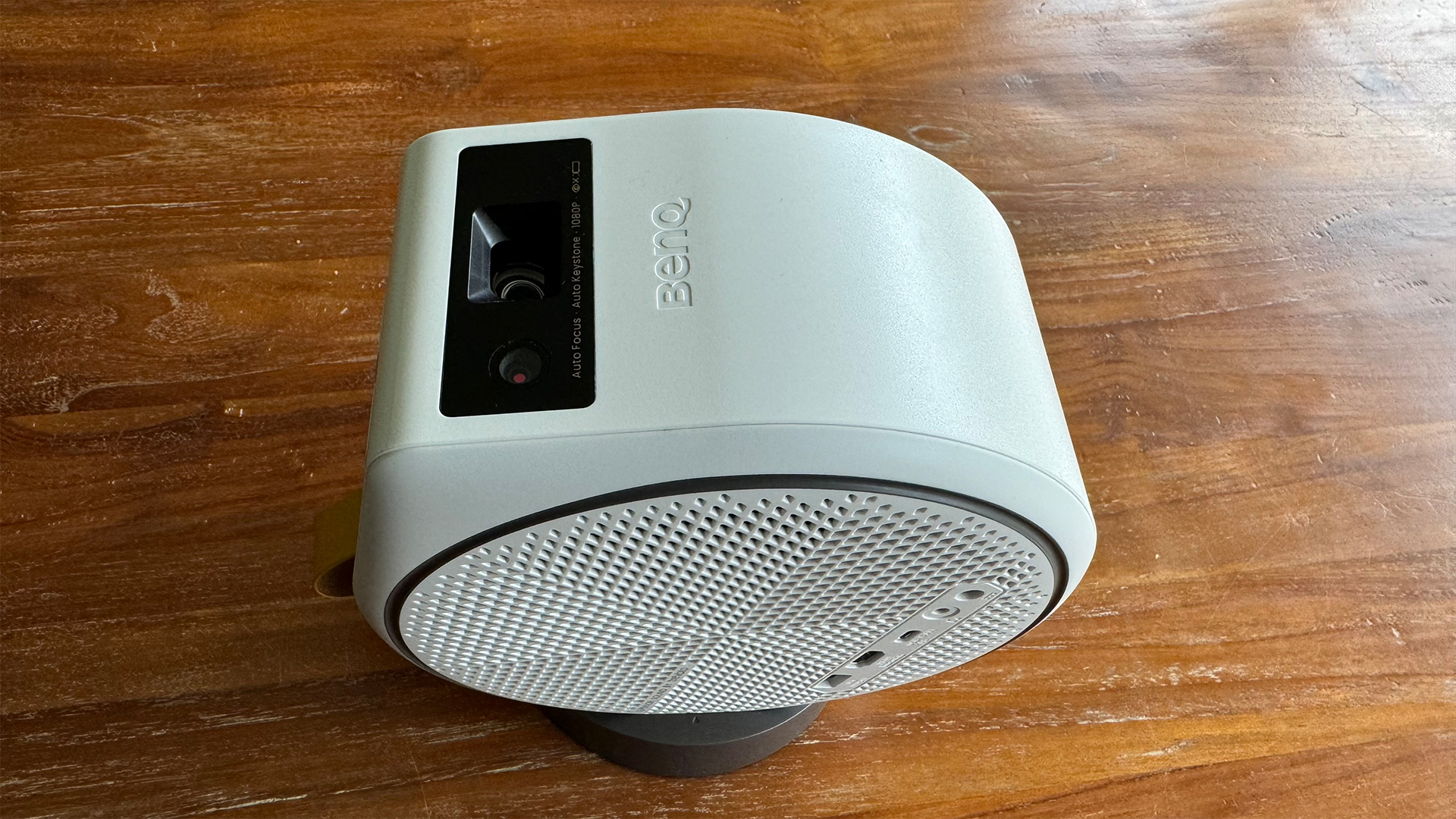
Skin tones and heavy reds can look a little forced, if we’re being really picky, but seldom enough to not count as a serious distraction. And definitely not enough to stop the GV31’s pictures feeling impressive for such a cheap and handy projector.
The GV31’s presets all feature brightness set to 50 per cent of its potential maximum in their default settings. It’s tempting to crank this up given the projector’s brightness limitations, but 50 per cent turns out to be the optimal point for most presets, as pushing them higher causes colours to fade, black levels to grey over, and white parts of the image to start looking bleached and unnatural. The only exception is the Living Room mode again, as it has enough core colour and contrast strength to allow you to nudge the brightness up five to 10 notches without the picture starting to suffer too much.
The GV31 gets good value out of its Full HD resolution. HD sources look consistently sharp and crisp, without any exaggerated object edging or grittiness to suggest the sharpness is a result of processing rather than innate to the DLP optics. Curved edges look clean rather than jagged or stepped, too. The HD image only starts to look a touch soft or ‘stretched’ at image sizes beyond 90 inches – at sizes, in other words, beyond those we’d recommend you watch on the GV31 anyway because of its limited brightness.
There are one or two other small niggles to report. Peak white colours can take on a faint mauve tone from time to time, and motion with 24p sources can sometimes exhibit a slightly awkward combination of slight blur and stutter. There’s not enough in either of these issues, though, to stop the GV31’s images from exceeding our expectations of what such a cheap and convenient projector design might be capable of.
Sound
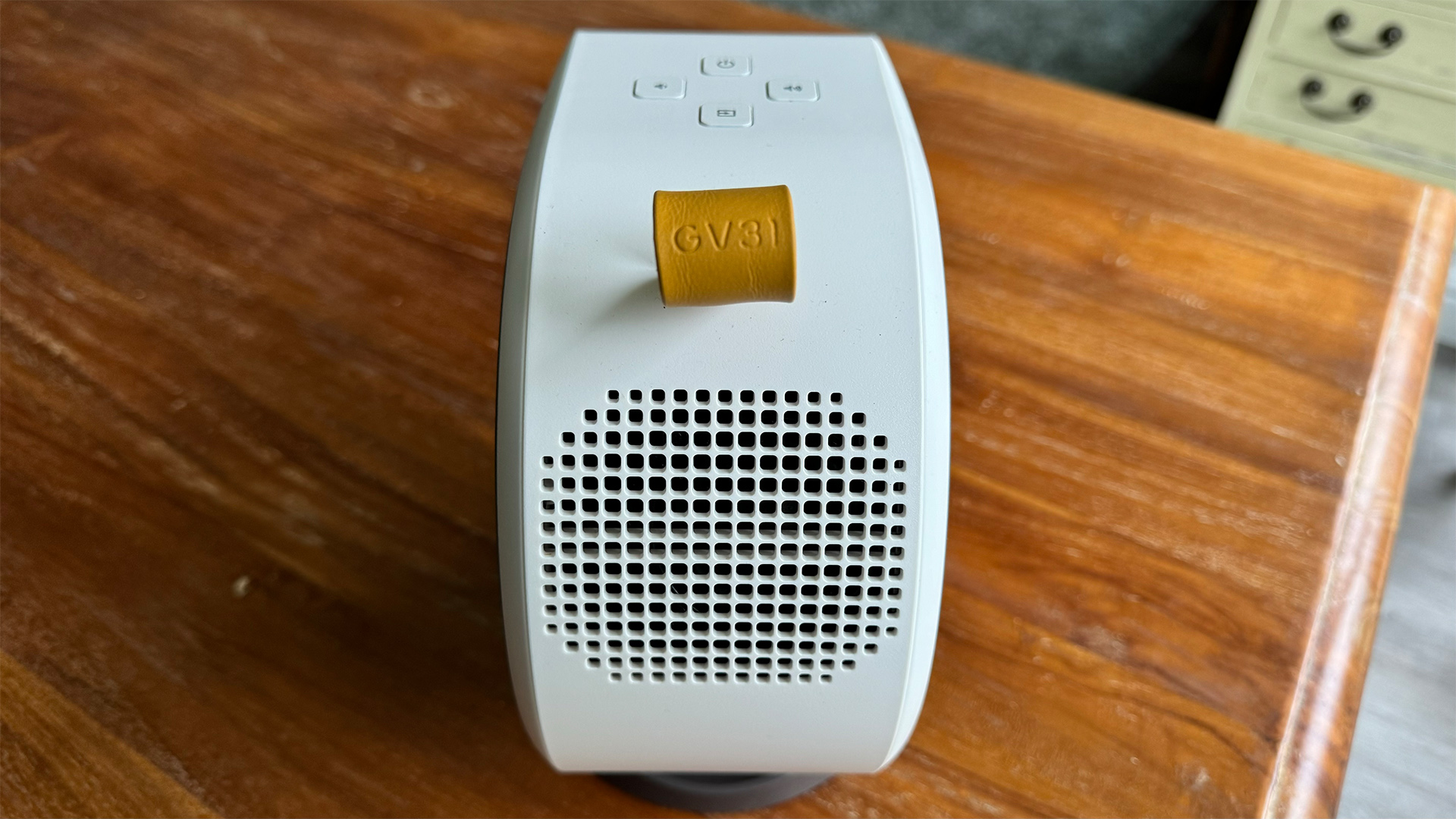
In an unusual development for the small projector market, the GV31’s sound is actually pretty good. It can get loud enough, for starters, to satisfy even a fairly large room, and it casts sound far enough from its bodywork to ensure that the audio actually seems to be connected with the distant pictures the projector is producing – especially if you’re sat somewhere behind the projector.
The sound has a crisp and clean quality to it as well, and its midrange is open and dynamic enough to stop even quite dense movie soundtrack moments from appearing compressed, thin or harsh. Voices can sometimes sound just a touch over-emphasised, but that’s far preferable to them becoming muddy or distorted.
The star of the GV31’s audio show, though, is its bass. The subwoofer ‘chamber’ adds genuine impact and heft to film soundtracks, reaching deeper and projecting its low frequencies further than you’d think possible from such a compact device. Not surprisingly, it can succumb to a little distortion and ‘bottoming out’ with some of the film world’s most extreme bass rumbles. But this doesn’t happen nearly as often or nearly as aggressively as you’d imagine.
Remarkably, the GV31’s speaker configuration even makes it passable as a portable music speaker.
Verdict
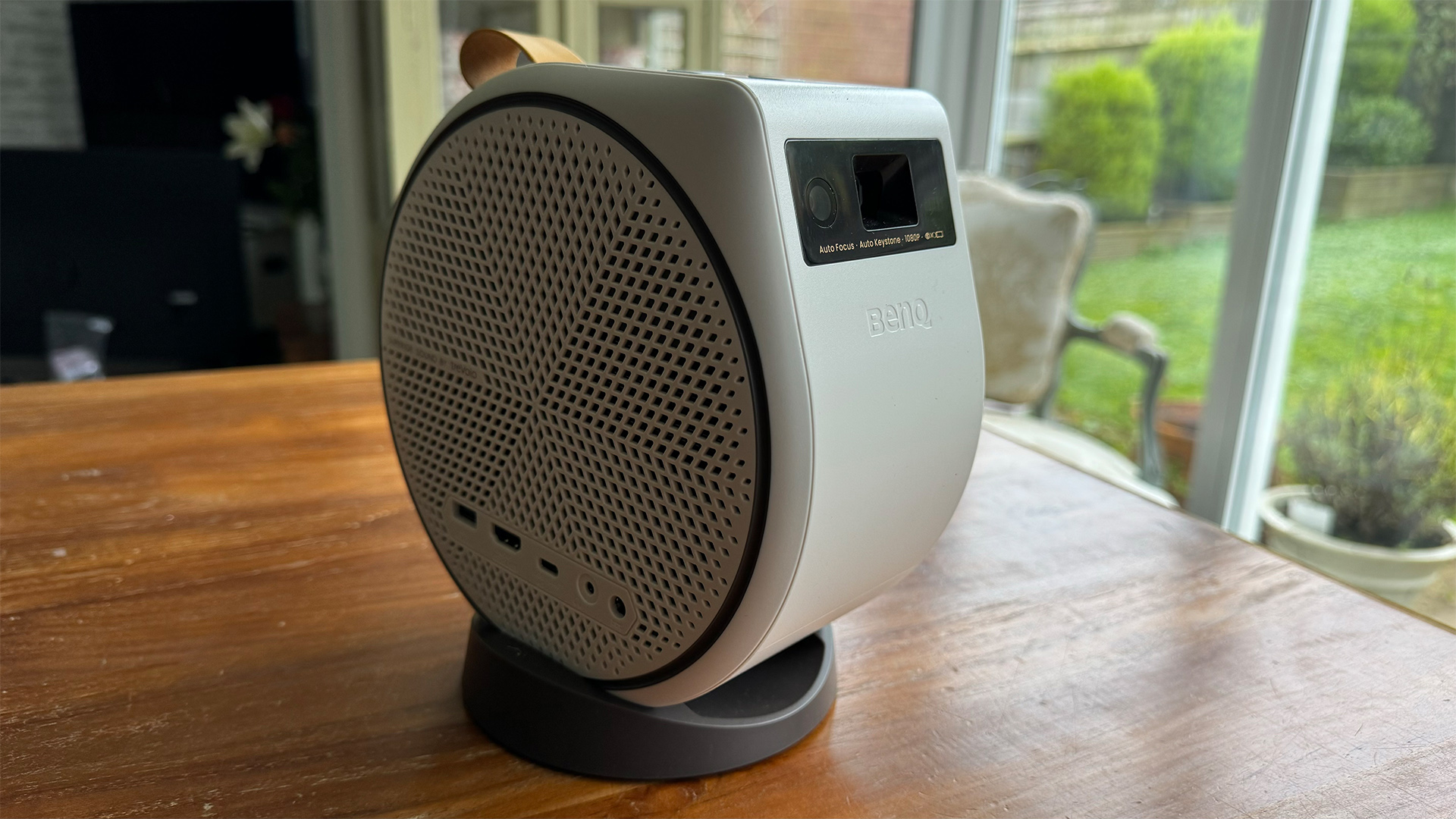
The BenQ GV31’s limited brightness also limits its potential audience. It really needs to be used in as dark a room as you can manage, and it struggles to deliver image sizes above 70-80 inches.
Provided you can work within these set-up limits, though, the BenQ GV31 is actually a surprisingly strong performer, delivering way more powerful sound as well as more sharpness, richer colours and, especially, deeper black levels than the vast majority of overtly ‘lifestyle’ projector designs do.
SCORES
- Picture 4
- Sound 4
- Features 4
MORE:
Read our review of Samsung's The Freestyle
Also consider the Anker Nebula Mars Air 3
Read our Anker Nebula Capsule 3 review







